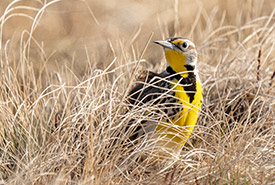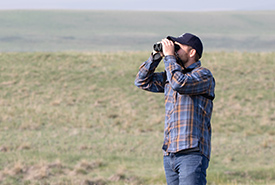Keeping the song of the prairie alive
Grassland songbirds are some of the fastest declining birds in North America
Western Meadowlark by Leta Pezderic / NCC Staff
Not everyone has had the chance to experience the chorus of grassland songbirds on a cool prairie dawn, but those who have, understand their importance and beauty.
A perilous decline
One of the most captivating parts of Prairie ecosystems is grassland birds. From singing songbirds to soaring hawks, grassland birds are a diverse group of species; each is adapted to the challenges of living on the open prairie in their own unique way.
But grassland birds are in trouble. They are one of the fastest declining groups of birds in North America. According to the 2019 The State of Canada’s Birds report, Canada has lost about 57 per cent of its grassland birds, a decline exceeded only by our aerial insectivores, some of which, like common nighthawk, are also found in Prairie environments.
And the more species rely on grasslands, the more trouble they seem to be in. According to the report, species that are showing the most rapid decline are those that are dependent on native grassland habitats — they have declined by a staggering 87 per cent.
Some of the fastest declining grassland birds are songbirds.
For example, thick-billed longspur has declined by 96 per cent from 1970 to 2019, according to data from the North American Breeding Bird Survey (BBS). These mostly grey and white birds are found in southeastern Alberta and southwestern Saskatchewan, and perform a spectacular flight display in which they fly up into the sky, outstretch their wings and float down to the ground as they sing.
Over the same period, Sprague’s pipit declined by four per cent per year. These drab birds are seldom seen near the ground, but their song can be heard from afar as they perform their spiraling aerial flight display at close to 100 metres in the air.
As a result of these declines, several species of grassland songbirds are now listed under Canada’s Species At Risk Act, with some also being protected under provincial legislation. These include several songbird species found in upland grassland habitats, such as chestnut-collared longspur and Baird’s sparrow, in addition to the two species mentioned already.
Even some species not yet considered at-risk have exhibited severe declines. For example, western meadowlark, a once-common grassland species — whose loud, warbling song is considered by many as emblematic of the prairie — has declined by over one per cent a year, as per BBS data.
These alarming trends are signs that it’s not just the grassland birds that are in trouble, but grassland ecosystems as whole are. Songbirds are considered an indicator species — their presence can show that an ecosystem is functioning and healthy, while their disappearance can show that serious issues are afoot.
Want to help grassland songbirds? Support NCC’s Prairie Grasslands Action Plan today!
Threats across their journey
A group of passionate wildlife researchers is studying grassland songbirds and their decline. One such wildlife biologist is Adam Moltzahn, NCC’s natural area manager for south-central Alberta, who has surveyed species at risk, including grassland songbirds, throughout his career.
The reason why Canada’s grassland songbirds are disappearing is complicated, explains Adam.
“It’s a group of species where it is a mix of different factors causing their decline; it’s not just one thing,” says Adam.
Canada’s grassland songbirds are migratory, with some species travelling as far south as South America to spend the winter. As a result, they face a range of threats throughout their life cycle, within both their breeding and overwinter habitat, and as they travel between each.
In Canada, one of the primary threats these birds face is the loss and fragmentation of their grassland breeding habitat. Since European colonization, over 70 per cent of Canada’s prairie grasslands have been lost to conversion, and what remains are often smaller parcels, reduced in quality by disturbances, such as industrial development, and by the invasion of exotic plant species.
That is why conserving large, remaining tracts of grassland and partnering with livestock producers to implement beneficial management practices is so important to grassland songbirds, and other Prairie species.
Enjoying this story? Sign up for our newsletter!
Similar but different
Key to recovering grassland songbirds is the sustainable management of their habitats. That’s because while these songbirds all rely on grasslands, they differ in the types of environmental conditions they need.
“Each one requires different habitats across the landscape for breeding purposes, for foraging and for nesting sites,” says Adam.
For example, Sprague’s pipit prefers areas of taller grasses with accumulated litter, referring to the layer of decaying plant matter above the soil.
“Sprague’s pipit are ground nesters, so they use the litter, or thatch, from the year before to build their nests in clumps of grass,” says Adam. “Then they cover their nests with live grass.”
Other birds, such as thick-billed longspurs, prefer areas that are relatively barren with low litter amounts.
“They don’t like a lot of vertical structure, meaning a lot of tall grasses or shrubs,” says Adam.

Adam Moltzahn surveying grassland birds (Photo by Kayleigh Weaver / NCC Staff)
Manufacturing a mosaic
To cater to the preferences of each species, grasslands are managed so they offer a "mosaic” of different habitats on the landscape. And central to grassland management is grazing, which today, is typically done by cattle.
One of the ways this mosaic is achieved is rest-rotational grazing. This refers to the practice of allowing cattle to graze certain pastures while resting others, alternating which are grazed and when, and which are rested.
“You might have the cattle graze part of the ranch one year, then you let it rest for a couple of years while you focus grazing to another part of the property or ranch in another year,” explains Adam. “As grasses and other natural vegetation are recovering and regrowing from being grazed, horned larks and chestnut-collared longspurs may nest and forage in those recently grazed areas of the ranch, while other areas that have not been touched for a couple of years can support birds like Sprague’s pipit.”
This dynamic is example of how stewardship by ranchers is essential for grassland biodiversity today.
“Ranchers and other landowners are doing a great job keeping grassland on their property which serves as vital breeding habitat for a multitude of species,” says Adam.
Seeing is believing
Each June, Adam conducts grassland bird surveys on NCC projects in southern Alberta. This is done to catalogue what species are found at each, which can help inform management decisions for these properties.
“Waking up before the sun rises on some of the longest days of the year is difficult, but worth it in the end,” says Adam. “When you go out at 5 a.m., right at sunrise, the prairie is just alive with song. Getting up at three in the morning is a challenge, but I never regret it once I am out — grassland songbirds simply make the prairie come alive.”




